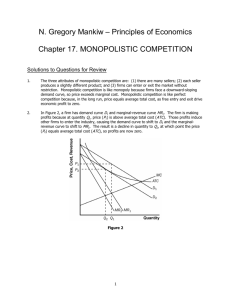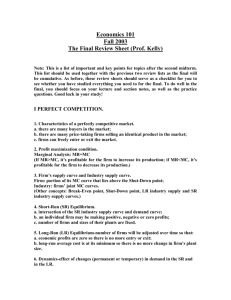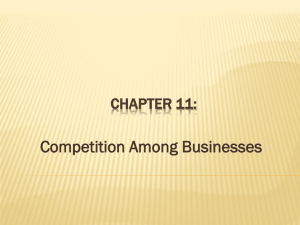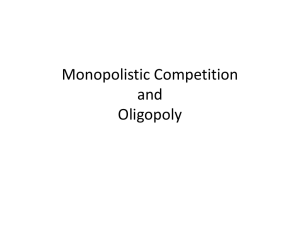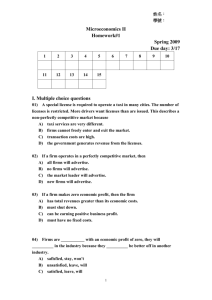Market Structure and Pricing
advertisement
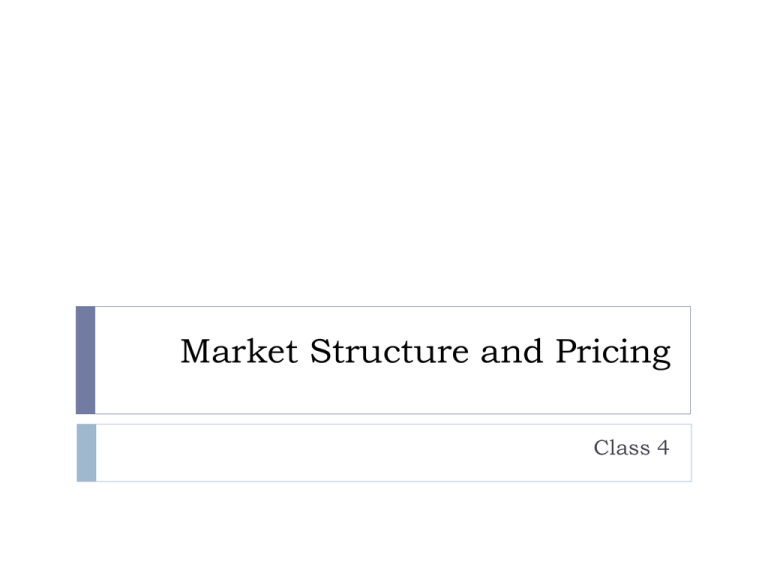
Market Structure and Pricing Class 4 Market Structures A market is an arrangement which links buyers and sellers. Ebay Local fish market A ticket counter at rugby match Amazon Stock market The term market structures refers to certain market characteristics. i.e Firms output and pricing behavior Perfect Competition Monopoly Monopolistic Competition Oligopoloy Perfect Competition There are many buyers and sellers in the market so no single firm has any control over the price of the product Perfectly Competitive firms are PRICE – TAKERS Stock markets, agricultural markets show some characteristic of perfectly competitive markets. Identical products offered by sellers. – No differentiation Freedom of Entry and Exit Buyers know the prices charged by all the firms. Perfect knowledge Monopoly One firm dominates the market. Examples Dutch East Indian Company (1602) The Sri-Lankan Cricket Board. De Beers Diamonds Railways Monopolists are price makers In Class assignment What are the advantages of a monopoly? Monopolistic Competition and Oligopoly Monopolistic competition Large Number of firms Selling Differentiated products Price Differentiations are small. Oligopoly A handful of large firms are able to control supply Car companies are oligopolies. Market types Perfect Competition Monopolistic Competition Oligopoly Monopoly Firms Large number Large Number Small Number One Products Identical Differentiated Similar. Differentiated No close substitutes Barriers to entry and exit No barriers Freedom of entry and exit Some barriers to entry Effective barriers to entry Control over market price No Control Small Control Substantial control Significant control. Revenue Concepts Total Revenue Average Revenue AR = TR/Q = (P*Q)/Q = P Marginal Revenue TR = P * Q MR = Change in TR/ Change in Quantity Objectives of the firm Traditional objectives of the firm is profit maximization (TRTC) Sales Maximization is maximizing TR Equilibrium Analysis Equilibrium – is when a firm reaches MR = MC In a purely competitive market we find three types of equilibrium Slope of TR is MR Slope of TC is MC TR-TC = Profit The slopes of TR and TC are equal when P is highest. Hence the highest profit is when MR=MC Of the firm Of the market Of the industry The two questions a firm has to ask Whether to produce anything at all. How much to produce if at all Nuwara Eliya Milk Farms Quantity Total (Q) Revenue (TR) Total Cost (TC) Profit (TR-TC) Marginal Revenue (MR=(∆T R/∆Q) Marginal Change Cost in profit (MC = (MR-MC) ∆TC/∆Q) 0 0 3 -3 - - - 1 6 5 1 6 2 4 2 12 8 4 6 3 3 3 18 12 6 6 4 2 4 24 17 7 6 5 1 5 30 23 7 6 6 0 6 36 30 6 6 7 -1 7 42 38 4 6 8 -2 8 48 47 1 6 9 -3 We learned that rationale people think on the margin (Class 1) If Marginal Revenue > Marginal Cost – The farm should increase production If Marginal Revenue < Marginal Cost – the farm should reduce production The cost curves have three primary features MC Curve is upward sloping ATC curve is U Shaped MC curves crosses the ATC curve at the minimum of ATC Perfect Competition The Market price is horizontal (Because the firm is a price taker) The profit Maximizing condition for a perfectly competitive firm is MR = MC = P 9 8 7 6 5 AR=MR=D=P 4 MC 3 2 1 0 0 2 4 6 8 10 Temporary Shut Down Vs Permanent Exit Shut Down – Short run decision to not produce anything Permanent exit – Long run decision to exit the market. Most firms cannot avoid fixed costs in the short run Firms Decision to Shut Down Total Revenue < Total Variable Cost Price < Average Variable Cost Firms Decision to Exit Permanently Total Revenue < Total Cost Price < Average Total Cost If this is the exit then Price > ATC – is the entry Measuring Profit Profit = TR – TC [(TR/Q)-(TC/Q)]* Q (We have not changed anything) [Average Revenue (AR) – Average Total Cost (AC)]* Q Price = AR Profit = (P-ATC) *Q So if ATC < P then you increase production If ATC >P then you decrease production What do perfectly competitive firms stay in business if they make 0 profit. Monopoly A monopoly is a price maker Competitive market P=MC Monopoly P> MC The monopolist profit is not unlimited because of the demand curve Why monopolies arise Simply its due to the barriers of entry Monopoly resources – a key resource used for production is owned by one firm (Diamonds) Government regulation – the government gives a single firm the right to produce some good or service (railways) The production process – economies of scale so the costs are much lower in one firm over the others. Monopoly Q P T2R (PQ) AR (TR/Q) 0 11 0 - 1 10 10 10 2 9 18 9 3 8 24 8 4 7 28 7 5 6 30 6 6 5 30 5 7 4 28 4 8 3 24 3 MR (∆TR/∆Q) The monopolist profit We know the optimal point is when MC intersects the demand curve However monopolies charge the monopoly price and they get an excess profit Price Discrimination Price discrimination is when a monopolist charges different prices for the same product to minimize the dead weight loss. Examples Airline tickets Books sold to different regions. Class Exercise: Explain the Dead Weight Loss? Imperfect Competition Imperfect Competition Monopolistic Competition Competition Shortcomings of the monopolistic markets A monopolistic competitive firm is inefficient. Average total cost is not at a minimum. There is a lot of information for the consumer to collect and process to make the best decisions. Advertising increases cost but advertising is essential to differentiate. Monopolistic Competition Graph Oligopoly Competition amongst a few Reasons Economies of scale Barriers to entry Mergers Horizontal Mergers – Involves firms selling a similar product Vertical Merger – A merger between suppliers and buyers Conglomerate merger – A merger between firms selling unrelated products Strategic Alliances The kinked demand curve An oligopoly’s demand curve is usually described as “kinked” There are two assumptions in play A price increase in one firm will not result in a price increase in the other A price decrease in one will result in a price decrease in the other. So when prices increase the curve is elastic When prices decrease the curve is inelastic This creates the kink. Other Price Policies in Oligopoly Markets Price Leadership Predatory Pricing One firm is accepted as the price leader, the price leader will be the first to adjust prices A large diverse firm that can stand temporary losses, will cut prices to run others out of business. (This is illegal) Price Fixing Formal agreements (This is somewhat illegal too) For example Cartels (OPEC) Break Time



